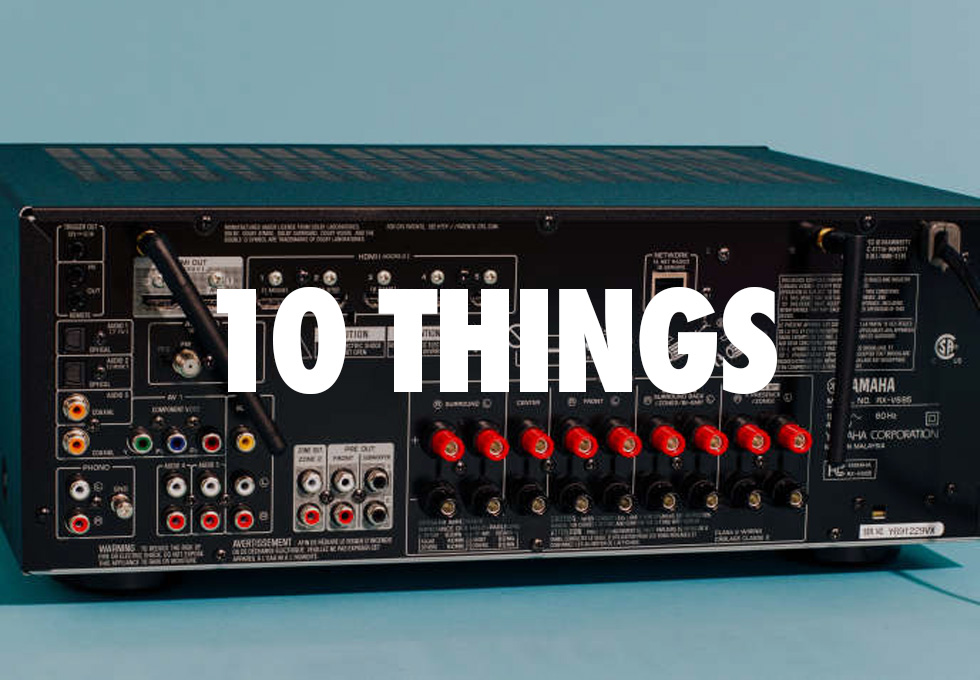10 Things to Consider When Shopping for an AV Receiver
10 Things to Consider When Shopping for an AV Receiver

Here are 10 things to consider when you begin the search for the right AVR to suit your needs.
1. Inputs and Outputs
– As of 2016, most mainstream AVRs support HDMI 2.0 inputs with HDCP 2.2 copy protection. This allows them to pass 4K/UHD and 3D content from the source device through the AVR to the display.
– To pass HDR10 content from Ultra HD Blu-ray and online providers with a compatible Roku or Chromecast streamer, you need an AVR that supports HDMI 2.0a with HDCP 2.2.
– Try to determine if the HDMI ports operate at 10.2 or 18 Gbps; they should operate at 18 Gbps if possible.
– An HDMI input on the front panel is a plus if you plan to connect and disconnect a source on a regular basis—for example, a gaming console or camcorder.
– Some AVRs offer more than one HDMI output. With two HDMI outputs, you can feed a projector for nighttime viewing and a flat-panel TV in the same room for daytime viewing. Alternatively, you can send the second HDMI output to a TV in another room, though this will probably require a fiber-optic or coax HDMI cable for such a long run.
– Some AVRs offer an asynchronous USB DAC, which lets you send digital-audio bitstreams from high-res audio source devices. This is important for audiophiles.
– If you have source devices that rely on optical or coaxial digital connections, make sure the AVR you choose has enough of these inputs to suit your needs.
2. Power Rating
– Power ratings for AVRs typically come with many caveats; for example, power ratings typically refer to only one or two channels being powered.
– The more channels you need to power at once, the lower the output of each channel. But it’s extremely rare for a movie or music to demand equal power from all channels simultaneously, so this is less of an issue than it might seem.
– There’s not a lot of difference between 100 watts and 120 watts, or 80 watts and 110 watts. All else being equal, small increases in power ratings do not represent much of an upgrade.
– Most AVR power ratings are specified with a speaker impedance of 8 ohms, which is very common among consumer speakers. If your speakers have a lower nominal impedance, they will draw more power from the amplifiers; be sure the AVRs you are considering can safely drive speakers with less than 8-ohm impedance.
– Many AVRs advertise power ratings into speaker impedances of 6 or even 4 ohms with very high THD (total harmonic distortion) figures; with THD, the lower, the better.
– The sensitivity of your speakers will have a greater impact on how loud your system can play than the power rating of an AVR.
– The power rating of an AVR does not need to match the power-handling spec of your speakers, but they should be in roughly the same ballpark. Under most conditions, the AVR is supplying no more than one or two watts to the speakers.
– For a hybrid high-performance solution, consider an AVR with preamp outs connected to a dedicated amplifier for the three front channels, which typically consume the most power. With some nine-channel AVRs, adding a 2-channel amp lets you take advantage of 11-channel processing.
3. Immersive Audio
– Support for immersive audio—that is, sound from speakers placed around and above the listening position—has become nearly ubiquitous in modern AVRs.
– You can get Dolby Atmos and DTS:X capability in very affordable AVRs.
– Auro 3D is a paid add-on for upper-tier AVRs from some brands. However, there isn’t much content encoded in Auro 3D yet.
– Seriously consider a 9-channel AVR that gives you 5.1.4 channels (five main channels, one subwoofer channel, four overhead or height channels) if you want the full immersive effect. 5.1.2 is good, but 5.1.4 (and 7.1.4) systems can convey movement and ambience better.
4. Number of Amplifier Channels
– As a general rule, more amplifier channels will cost you more money. Therefore, it is important to decide how many speakers you need to power ahead of time.
– 5-channel AVRs are the most basic and typically the most affordable.
– 7-channel AVRs can handle Dolby Atmos and DTS:X in a 5.1.2 speaker configuration as well as traditional 7.1 speaker systems.
– 9-channel AVRs can handle 5.1.4 Atmos and DTS:X, which offers a superior immersive experience to systems with only two elevation channels.
– Some 9-channel AVRs also offer 11-channel processing, but you’ll need an external 2-channel amp to take advantage of that.
– This year there are several 11-channel AVRs to choose from; these models can handle 7.1.4 Atmos/DTS:X or amplify multiple zones.
5. Room Correction
– Room correction—compensating for acoustical irregularities in a given room—is one of the most important features to consider when deciding between different brands of AVRs.
– Some companies, such as Yamaha, Pioneer, and Onkyo, use their own proprietary systems, while others, like Denon and Marantz, license sophisticated third-party solutions such as Audyssey and Dirac Live.
– There is a lot of variation in terms of capability between different room-correction systems.
– Audyssey MultEQ XT32 and Dirac Live both have a reputation for being very effective.
– Some speaker and room combinations benefit from room correction more than others.
6. Networking
– Whether you need it or not, a 2016-model AVR is likely to have some sort of network connectivity.
– An Ethernet port is useful if you plan to locate the AVR far from a wireless router or use IP control in conjunction with a home-automation system. Also, a wired Ethernet connection assures the best possible performance for audio streamed from other devices on the network.
– Many AVRs use Wi-Fi to offer compatibility with Apple AirPlay, DTS Play-Fi, and other wireless AV systems.
– Another useful networking feature is playback from a DLNA server connected to your home network.
7. Wireless and Multi-Room Audio Features
– For many years, some AVRs have offered the ability to send audio and video to two or more separate rooms or “zones” in a home using dedicated hard-wired connections such as interconnect and speaker cables as well as analog video and even HDMI.
– These days, many AVRs come with some sort of networked-audio capabilities. Some brands only offer their own proprietary system such as Denon HEOS or Yamaha MusicCast, which work only with other compatible products from the same manufacturer. Other brands, like Pioneer and Onkyo, have adopted third-party platforms such as Google Cast and DTS Play-Fi.
– If you like to mix and match brands, the DTS Play-Fi ecosystem includes products from the most manufacturers.
– If you use Bluetooth, look for aptX technology, which ensures high-quality audio transmission.
– Some AVRs offer the option of streaming audio from cloud-based services.
8. Analog Inputs and 2-Channel Audio
– Unless you have a legacy video source, such as a LaserDisc player or VCR, analog video inputs, such as component or composite video, are completely unnecessary.
– If you have a collection of analog-audio sources, make sure there are enough analog-audio inputs to accommodate them on the AVRs you are considering.
– If you plan on listening to vinyl records, look for an AVR that offers a phono input; not all of them do.
9. Remote and App-Based Control
– Since AVRs are complex devices, they often come with remote controls that are stuffed with buttons.
– Many AVRs have included an RS-232 serial port for connection to home-automation systems from companies like Crestron, but this is being supplanted by IP control over your home’s network.
– Control apps for phones and tablets are available from many AVR makers, but their functionality varies widely. If like to control things with a mobile device, you might want to consider how capable the app is.
– Look for an IR input if you plan to use a standard remote and house the AVR in a cabinet or closet.
10. Budget and Recommendations
– The key to shopping for an AVR is to set your budget first, determine how many speakers you plan to power, factor in what sources you intend to connect, and consider the kind of content you intend to consume—some folks are music-first and others use AVRs primarily for home cinema.
Article originally written by
by Mark Henninger on October 24, 2016 on AVSForum





